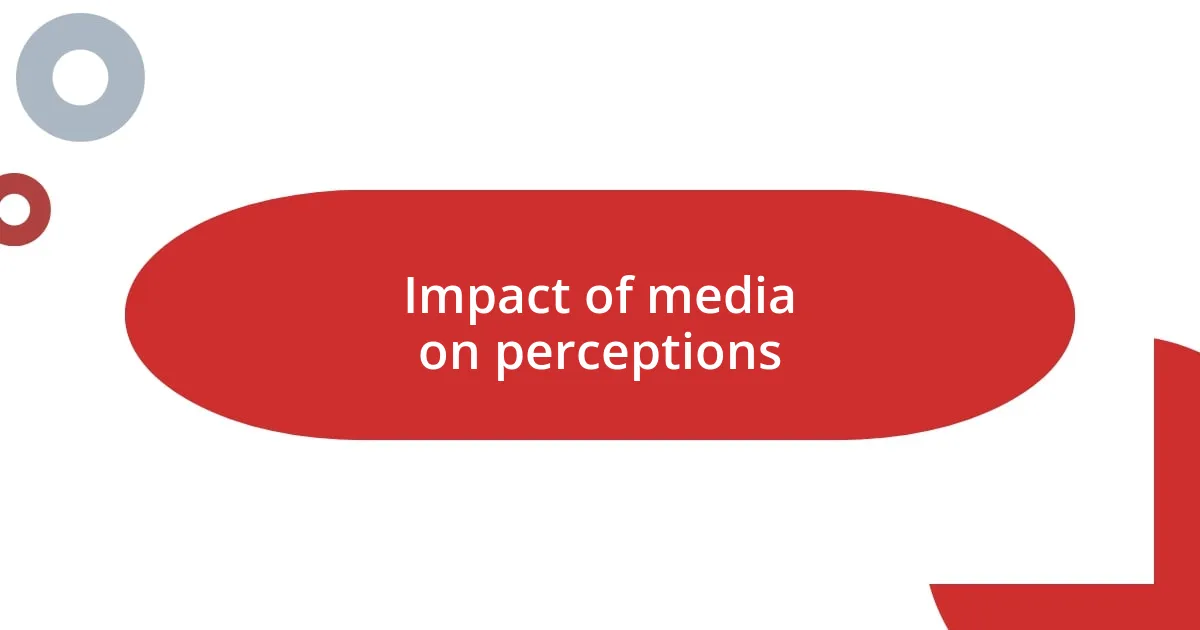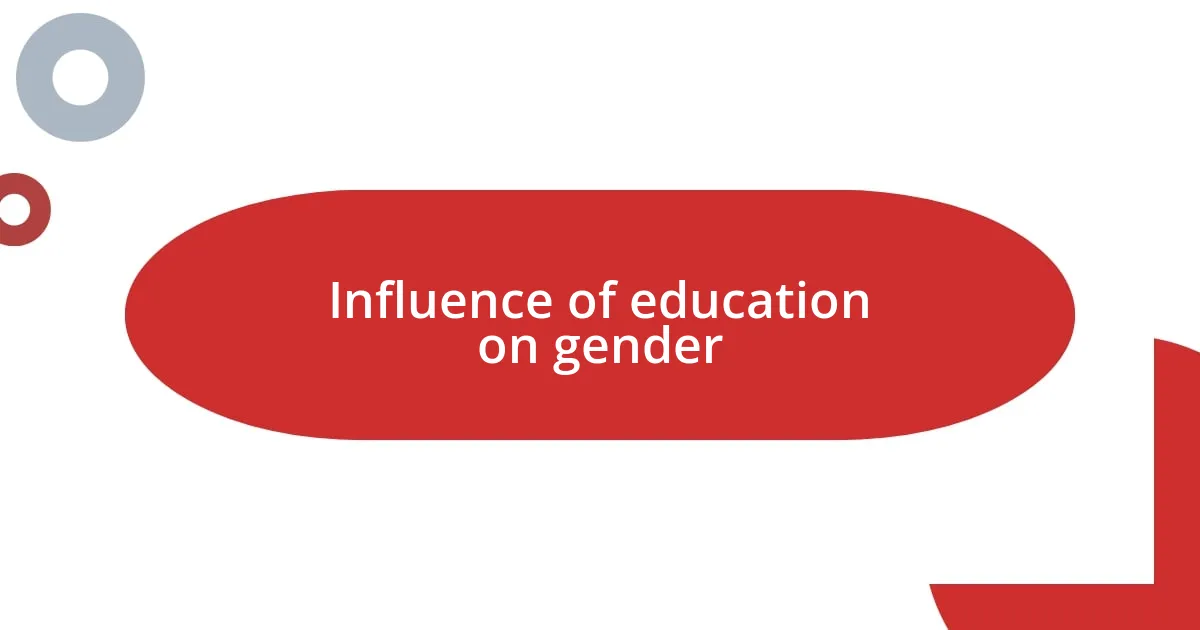Key takeaways:
- Gender roles are becoming more fluid, allowing individuals to break traditional stereotypes, as seen with the rise of stay-at-home dads and women in leadership.
- The feminist movement significantly challenged historical gender roles, promoting equality and changing societal expectations throughout the 20th century.
- Media impacts perceptions of gender roles, often reinforcing stereotypes but also providing platforms for diverse representations that can challenge the status quo.
- Education plays a crucial role in shaping gender perceptions, with modern initiatives encouraging gender equality and exploration of identities beyond the binary.

Understanding gender roles today
Gender roles today are more fluid than ever, allowing individuals to express themselves beyond traditional expectations. I often find myself reflecting on how my friends challenge these norms; for example, a close friend of mine broke stereotypes by becoming a stay-at-home dad while his wife pursued her career. Isn’t it refreshing to see how these shifts can lead to more balanced partnerships?
I remember chatting with a group of young adults about the pressures they feel to fit into predefined roles. One thought struck me: how many people hide their true selves just to conform? It makes me think—what would happen if we all embraced our unique identities rather than conforming to societal pressures?
As I observe the increasing awareness around gender inclusivity, I can’t help but feel hopeful. This change is not just about redefining male and female roles; it’s about recognizing the spectrum of identities that exist within our communities. Have you ever considered how embracing this diversity can foster healthier relationships?

Historical context of gender roles
Understanding the historical context of gender roles offers a lens through which we can view the evolution of societal expectations. Traditionally, roles were starkly defined; men were seen as providers while women took care of the home. I often think about my grandparents’ relationship, where my grandmother would dedicate her life to raising the children, while my grandfather worked tirelessly to support the family. It’s fascinating to see how these norms were just accepted, not questioned.
As time progressed, especially during the 20th century, the feminist movement began to challenge these traditional roles, advocating for women’s rights and equality. I remember learning about the women’s suffrage movement and feeling a surge of admiration for those brave women who fought for the right to vote. Their courage ignited a ripple effect that gradually transformed our understanding of gender and the roles associated with it.
Today, we live in a world that’s increasingly recognizing the importance of gender equality. It’s staggering to me, considering how far we’ve come, yet it’s essential to acknowledge that remnants of historical gender roles still influence us. How often do we hear phrases like “women should…” or “men are supposed to…”? Reflecting on these phrases ignites a passion in me to continue advocating for an inclusive future.
| Era | Gender Roles |
|---|---|
| Pre-20th Century | Strictly Defined: Men as providers and women as homemakers. |
| 20th Century | Challenging Norms: Rise of feminism and the push for equality. |
| Today | Fluid Roles: Recognition of diverse identities and shifting expectations. |

Impact of media on perceptions
The media plays a significant role in shaping our perceptions of gender roles. Personally, I notice how shows and advertisements often portray men and women in specific ways, which can reinforce outdated ideas. For instance, I recently watched a popular sitcom where the father was depicted as bumbling and inept, while the mother expertly managed everything at home. While meant to be humorous, it highlights a subtle yet harmful stereotype that can influence viewers’ beliefs about competence based on gender.
Here are some key points regarding media impact on gender perceptions:
- Representation Matters: When diverse gender identities are showcased positively, it fosters acceptance and normalizes different roles.
- Stereotypes Persist: Certain media tropes continue to depict men as dominant and women as submissive, limiting our understanding of gender nuances.
- Social Media Influence: Platforms like Instagram and TikTok allow individuals to challenge mainstream portrayals, promoting more authentic representations.
- Consumer Behavior: Advertisers often leverage gender stereotypes, suggesting that certain products are inherently for one gender based on traditional roles, which can reinforce those roles in real life.
Reflecting on these aspects, I find it crucial for media creators to understand their influence and strive for more nuanced narratives. It’s empowering to see voices advocating for change in how gender is represented, revealing the potential for shifting societal norms through creative storytelling.

Influence of education on gender
Education is a powerful tool that shapes our understanding of gender roles. I often think about my own schooling and how gender biases were subtly woven into the curriculum. For example, during science classes, boys were typically encouraged to excel in technical subjects, while girls were often guided towards arts or humanities. Reflecting on that, I wonder, how many girls missed out on pursuing careers in STEM fields simply because they weren’t given the same encouragement?
In more recent times, educational institutions have started to actively promote gender equality. I recall attending workshops that discussed unconscious bias in the classroom, and it truly opened my eyes. By fostering an environment where both boys and girls can pursue their interests without stereotypes clouding their choices, we can encourage a more balanced view of gender roles. Isn’t it inspiring to think that today’s students might grow up with a more equitable understanding of their capabilities?
Moreover, the inclusion of gender studies in higher education is changing the game. I remember attending a lecture on the impact of gender identity on personal development, and it felt empowering. This kind of education allows individuals to explore various aspects of gender beyond the binary, paving the way for a more inclusive society. It raises the question—what if every educational system could embrace these discussions from an early age? The possibilities for change would be limitless.

Changing dynamics in the workplace
The workplace is undergoing a remarkable transformation when it comes to gender dynamics. I can’t help but notice how many companies are now prioritizing inclusivity, which feels like a long-overdue change. Just the other day, I attended a team meeting where my colleagues openly discussed our mentorship program’s impact on women in leadership roles. It was exciting to witness an environment where everyone was encouraged to share their thoughts, regardless of their gender. Isn’t it refreshing to see such dialogue simply becoming the norm?
In my experience, flexible working arrangements have really shaken up traditional roles in the workplace. I vividly remember when a friend of mine took paternity leave after his child was born; it was almost revolutionary. Most importantly, his decision didn’t come with any stigma—HR celebrated it! Such changes challenge the stereotype that caregiving is solely a woman’s responsibility, allowing for a more balanced distribution of tasks at home. How do you think this shift will affect our future workplaces?
Additionally, the rise of diverse leadership teams is a game-changer. I once attended a panel with prominent leaders from various backgrounds, and their stories were incredibly impactful. The mix of perspectives not only enriched our discussion but also demonstrated that effective leadership comes in many forms. This variety fosters innovation and reflects a broader understanding of gender roles today. It makes me wonder, are we finally moving towards a workplace where every individual’s strengths are recognized, and valued based on their unique contributions rather than their gender?

Role of social activism
Social activism plays a pivotal role in reshaping our perceptions of gender roles today. I remember attending a local rally advocating for women’s rights, and the energy in the air was palpable. It felt empowering to stand alongside passionate advocates, united in our mission to challenge outdated stereotypes and push for equal treatment. Isn’t it powerful to think that a collective voice can sway societal norms?
One of the most striking impacts of social activism is its ability to ignite conversations. I often find myself reflecting on the discussions sparked by campaigns like #MeToo and #TimesUp, which illuminated the pervasive nature of gender-based violence. These movements compelled individuals, including myself, to confront uncomfortable truths and understand the depth of gender inequality. How can we ignore the ripple effect of such dialogues that encourage personal growth and societal change?
Moreover, the rise of online platforms has amplified grassroots movements, making it easier for individuals to join the fight for gender equality. I once participated in an online seminar focused on dismantling gender stereotypes in media representation, and I was struck by the diverse perspectives shared. The accessibility of these discussions broadens the reach of activism and empowers everyone, regardless of location, to contribute their voice. Isn’t it encouraging to think that one tweet or post can spark a global conversation on gender roles?














